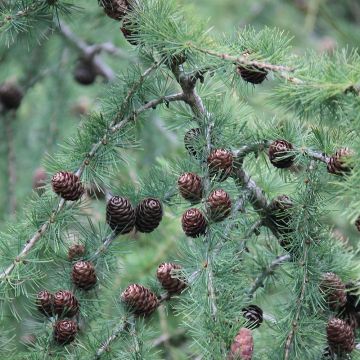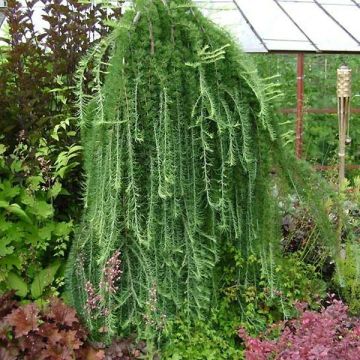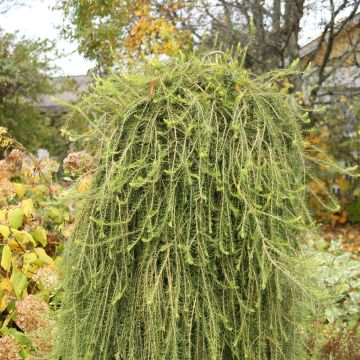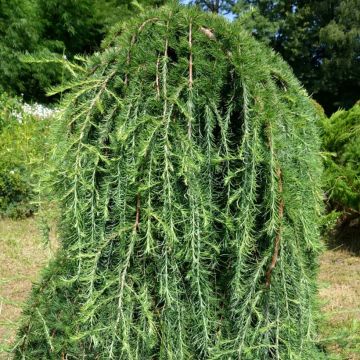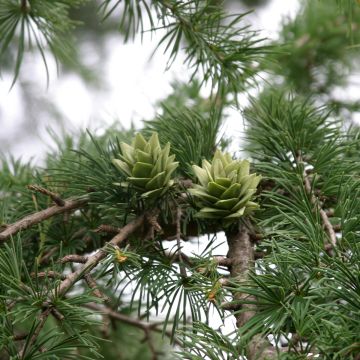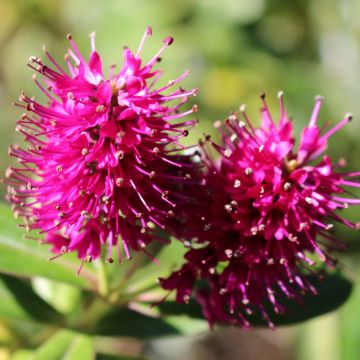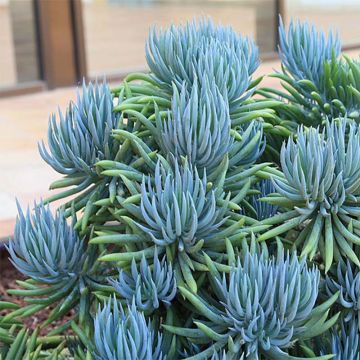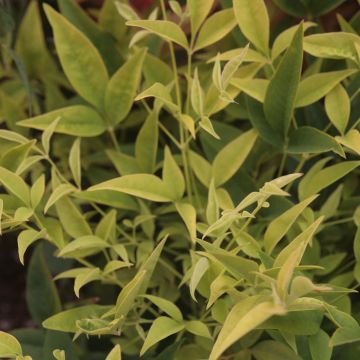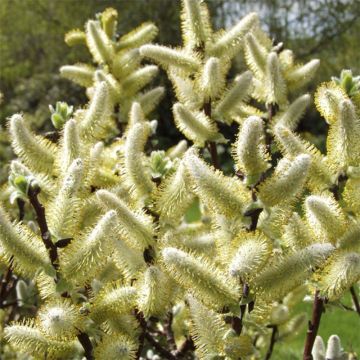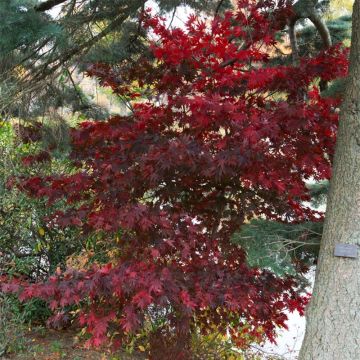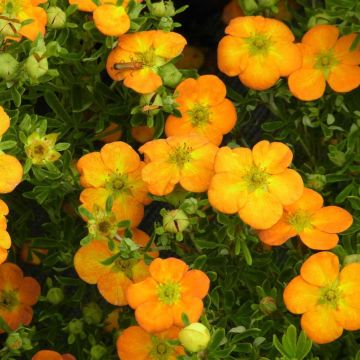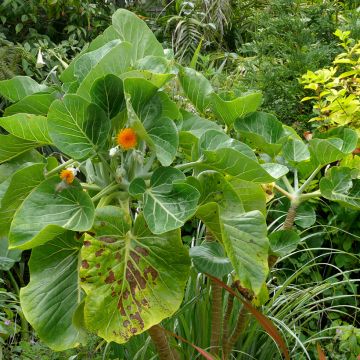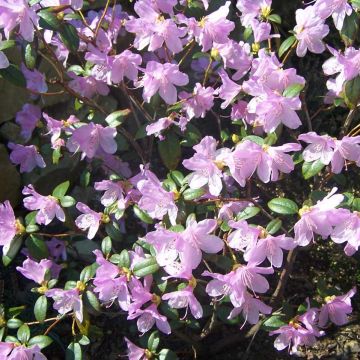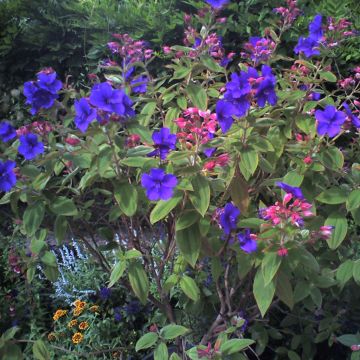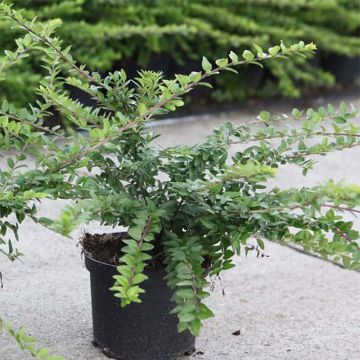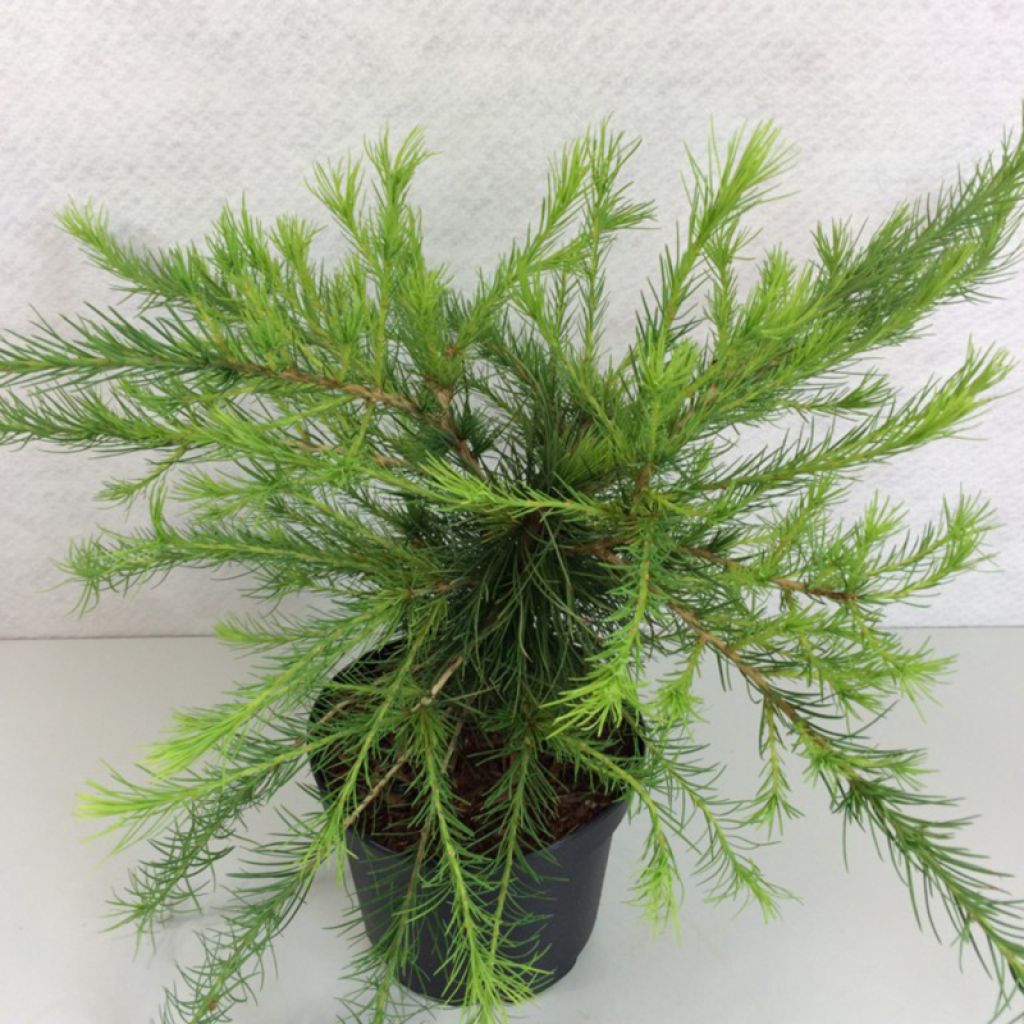

Larix laricina Arethusa Bog - Mélèze d'Amérique demi-nain
Larix laricina Arethusa Bog - Larch
Larix laricina Arethusa Bog
Tamarack, American Larch, Eastern Larch, Black Larch
Why not try an alternative variety in stock?
View all →This plant carries a 24 months recovery warranty
More information
We guarantee the quality of our plants for a full growing cycle, and will replace at our expense any plant that fails to recover under normal climatic and planting conditions.
From €5.90 for pickup delivery and €6.90 for home delivery
Express home delivery from €8.90.
Does this plant fit my garden?
Set up your Plantfit profile →
Description
Rare in cultivation, the Larix laricina 'Arethusa Bog, also known as the American larch, is a deciduous conifer of moderate size, with surprising architecture that evokes a 'witch's broom'. Its horizontal branches are adorned with trailing shoots, forming a dense crown that seems battered by the wind, attached to the earth via a slender trunk. Its small bluish-green needles turn to a brilliant yellow in autumn. With fairly rapid growth, it will be perfect in a small garden, at the back of a border, or as a standalone in a romantic garden. Very hardy, it requires light, acidic, fresh to moist soil, and a sunny exposure.
The American larch, also known as the Laricina larch, is a medium-sized conifer with a shaggy pyramidal habit that can reach 10 to 20 m (32 ft 10 in to 65 ft 7 in) in height, with deciduous foliage. It is native to the cold, marshy, and peaty regions of North America, up to Alaska. It belongs to the pine family, such as pines, firs, and spruces. It is a species of cold climate and peat bogs, often poorly drained.
The 'Arethusa Bog' variety is a semi-dwarf form discovered in the 1970s. After 10 years, it forms a bush with a somewhat disheveled look, with an irregular pyramidal and open habit, reaching 1.20 m (3 ft 11 in) in height and 60 cm (23.6 in) in width. Its growth is quite fast for a larch. Anchored on horizontal branches, its long shoots trail gracefully. The foliage, deciduous, consists of needles measuring 2 to 3 cm (0.8 to 1.2 in), spiralled on the shoots. From spring to summer, the foliage is generally bluish-green. The bright red cones are scaly, rose-shaped, tiny, not exceeding 1 to 2.3 cm (0.4 to 0.9 in) in length. They turn brown at ripeness. This larch, like all others, takes on a magnificent hue in autumn, here golden yellow. Covering its young stems, its beautiful old rose to pale brown bark makes an additional asset in winter.
The American larch 'Arethusa Bog' is a very original conifer, suited to acidic and fresh soils. It will work wonders in a small garden, in a Japanese or exotic border, provided it is placed in a very sunny exposure. In a romantic garden, it can be associated with heathland plants such as camellias and rhododendrons. It will pair well with bushy or spreading conifers. The real graphic qualities of conifers naturally impose themselves in the design of a contemporary garden, which prefers the aesthetics of shapes, silhouettes and textures to the waltz of flowerings. These plants structurally enhance a border, mark walkways, border the terrace, easily substituting the strong presence of pruned boxwood. They associate with shaggy grasses and heathers whose temperament is very complementary. The key is to play with volumes and colours.
The name of this bush means 'Arethusa's Bog'. In Greek mythology, Arethusa (which translates to fountain) is a nymph, a daughter of Nereus, who fled from her home in Arcadia to reappear as a spring on the island of Ortygia in Syracuse.
Advice: Water regularly during the first two years, and in case of prolonged drought.
Report an error about the product description
Larix laricina Arethusa Bog - Larch in pictures
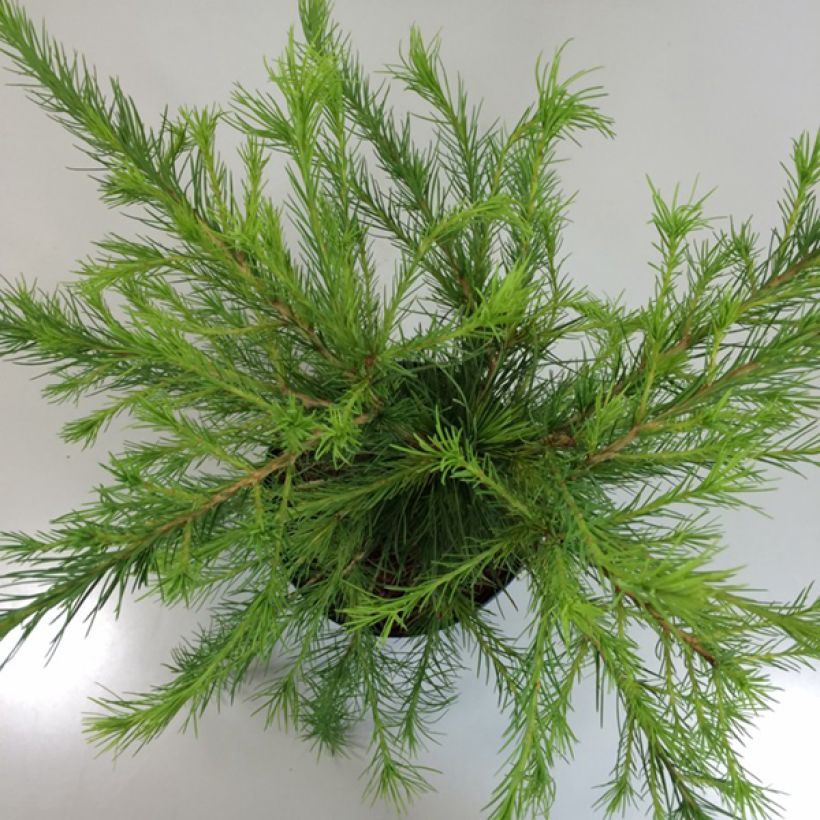

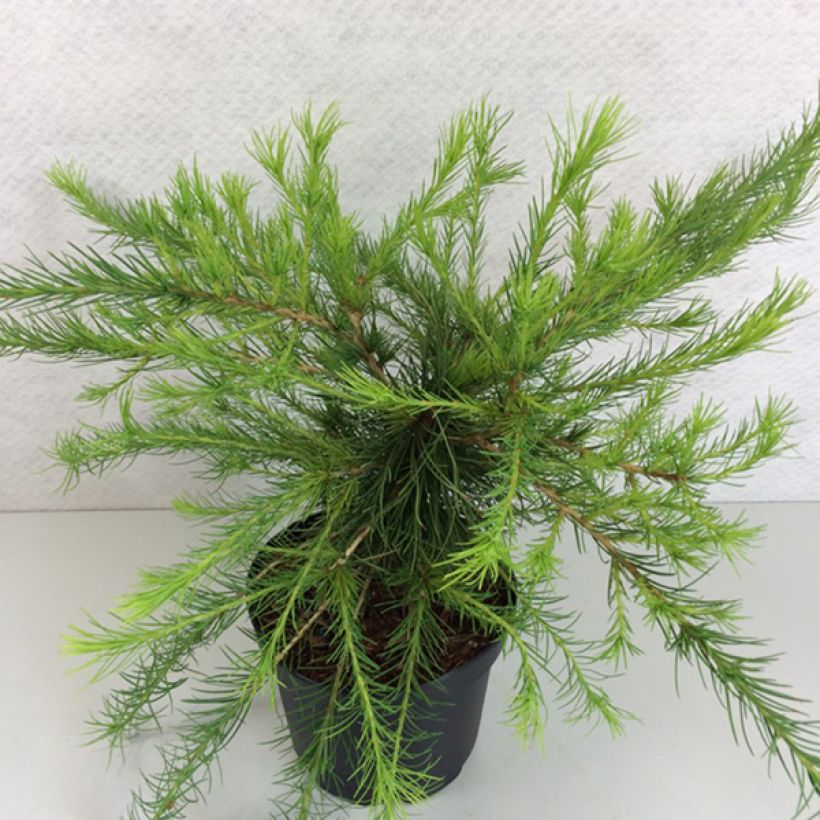

Plant habit
Flowering
Foliage
Botanical data
Larix
laricina
Arethusa Bog
Pinaceae
Tamarack, American Larch, Eastern Larch, Black Larch
Cultivar or hybrid
Other Larix - Larch
Planting and care
The Larix laricina 'Erethusa Bog' is an extremely hardy plant, adapted to cold climates. It fears arid situations and clayey, compact soils. It is planted from September to November in well-drained soil that retains freshness, even waterlogged, poor, acidic soil, in a very sunny place. A mixture containing coarse sand, heather soil and compost added to the garden soil will be very suitable. If your soil is too heavy, a small tip is to plant your bush on a mound and mulch it with gravel. Water regularly during the first two years, and in cases of prolonged drought. Soak the clods well before planting. Pruning is not necessary, but this conifer can be perfectly pruned to maintain or accentuate its original habit. It will then be carried out in February-March.
Planting period
Intended location
Care
-
, onOrder confirmed
Reply from on Promesse de fleurs
Shrubs for pots
Haven't found what you were looking for?
Hardiness is the lowest winter temperature a plant can endure without suffering serious damage or even dying. However, hardiness is affected by location (a sheltered area, such as a patio), protection (winter cover) and soil type (hardiness is improved by well-drained soil).

Photo Sharing Terms & Conditions
In order to encourage gardeners to interact and share their experiences, Promesse de fleurs offers various media enabling content to be uploaded onto its Site - in particular via the ‘Photo sharing’ module.
The User agrees to refrain from:
- Posting any content that is illegal, prejudicial, insulting, racist, inciteful to hatred, revisionist, contrary to public decency, that infringes on privacy or on the privacy rights of third parties, in particular the publicity rights of persons and goods, intellectual property rights, or the right to privacy.
- Submitting content on behalf of a third party;
- Impersonate the identity of a third party and/or publish any personal information about a third party;
In general, the User undertakes to refrain from any unethical behaviour.
All Content (in particular text, comments, files, images, photos, videos, creative works, etc.), which may be subject to property or intellectual property rights, image or other private rights, shall remain the property of the User, subject to the limited rights granted by the terms of the licence granted by Promesse de fleurs as stated below. Users are at liberty to publish or not to publish such Content on the Site, notably via the ‘Photo Sharing’ facility, and accept that this Content shall be made public and freely accessible, notably on the Internet.
Users further acknowledge, undertake to have ,and guarantee that they hold all necessary rights and permissions to publish such material on the Site, in particular with regard to the legislation in force pertaining to any privacy, property, intellectual property, image, or contractual rights, or rights of any other nature. By publishing such Content on the Site, Users acknowledge accepting full liability as publishers of the Content within the meaning of the law, and grant Promesse de fleurs, free of charge, an inclusive, worldwide licence for the said Content for the entire duration of its publication, including all reproduction, representation, up/downloading, displaying, performing, transmission, and storage rights.
Users also grant permission for their name to be linked to the Content and accept that this link may not always be made available.
By engaging in posting material, Users consent to their Content becoming automatically accessible on the Internet, in particular on other sites and/or blogs and/or web pages of the Promesse de fleurs site, including in particular social pages and the Promesse de fleurs catalogue.
Users may secure the removal of entrusted content free of charge by issuing a simple request via our contact form.
The flowering period indicated on our website applies to countries and regions located in USDA zone 8 (France, the United Kingdom, Ireland, the Netherlands, etc.)
It will vary according to where you live:
- In zones 9 to 10 (Italy, Spain, Greece, etc.), flowering will occur about 2 to 4 weeks earlier.
- In zones 6 to 7 (Germany, Poland, Slovenia, and lower mountainous regions), flowering will be delayed by 2 to 3 weeks.
- In zone 5 (Central Europe, Scandinavia), blooming will be delayed by 3 to 5 weeks.
In temperate climates, pruning of spring-flowering shrubs (forsythia, spireas, etc.) should be done just after flowering.
Pruning of summer-flowering shrubs (Indian Lilac, Perovskia, etc.) can be done in winter or spring.
In cold regions as well as with frost-sensitive plants, avoid pruning too early when severe frosts may still occur.
The planting period indicated on our website applies to countries and regions located in USDA zone 8 (France, United Kingdom, Ireland, Netherlands).
It will vary according to where you live:
- In Mediterranean zones (Marseille, Madrid, Milan, etc.), autumn and winter are the best planting periods.
- In continental zones (Strasbourg, Munich, Vienna, etc.), delay planting by 2 to 3 weeks in spring and bring it forward by 2 to 4 weeks in autumn.
- In mountainous regions (the Alps, Pyrenees, Carpathians, etc.), it is best to plant in late spring (May-June) or late summer (August-September).
The harvesting period indicated on our website applies to countries and regions in USDA zone 8 (France, England, Ireland, the Netherlands).
In colder areas (Scandinavia, Poland, Austria...) fruit and vegetable harvests are likely to be delayed by 3-4 weeks.
In warmer areas (Italy, Spain, Greece, etc.), harvesting will probably take place earlier, depending on weather conditions.
The sowing periods indicated on our website apply to countries and regions within USDA Zone 8 (France, UK, Ireland, Netherlands).
In colder areas (Scandinavia, Poland, Austria...), delay any outdoor sowing by 3-4 weeks, or sow under glass.
In warmer climes (Italy, Spain, Greece, etc.), bring outdoor sowing forward by a few weeks.

































